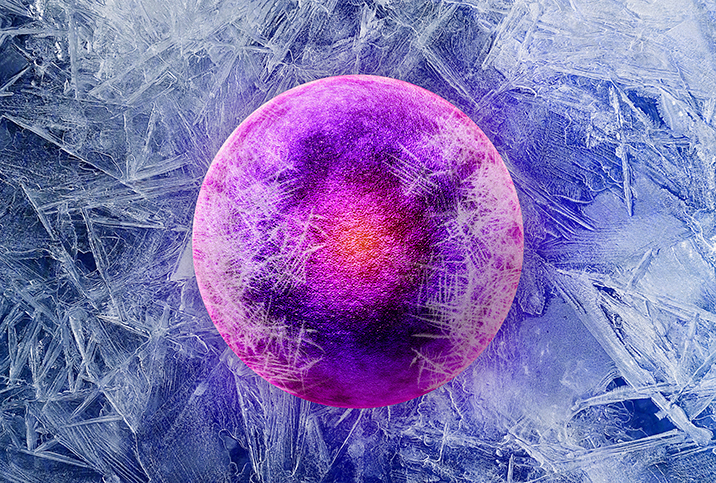The Facts About Freezing Eggs and Embryos

If you're interested in getting pregnant, but not right now, you'll be pleased to know you have some options: freezing eggs or embryos. Advances in fertility medicine allow women to preserve the viability of their reproductive material until they are ready to have a baby.
Freezing reproductive material is a great option for single mothers, same-sex partners and women who want to prolong fertility.
Should I freeze my eggs or embryos?
If you're unsure which option is better for you, eggs or embryos, you may want to consider the level of flexibility you want in the future. Embryo cryopreservation requires that fertilization happens before freezing, so this option requires you to determine the father of your child when you undergo the process rather than when the pregnancy takes place. If you want to decide who will be the sperm provider at a later date, freezing your eggs might be a better choice.
Fertilizing an embryo adds further complexity to the situation for some couples, depending on their beliefs. If you decide not to use the frozen reproductive material at a later date, you might feel more comfortable discarding unfertilized eggs rather than discarding a frozen embryo. Or it may not make a difference to you and your potential partner. Before making a decision, that aspect may be something to consider.
The last factor to consider is cost. While the costs of in vitro fertilization (IVF) vary widely, freezing embryos—compared to freezing eggs—is typically going to cost a few thousand dollars more.
Both options are completely valid and work for people in different stages of life and situations. So talk to your doctor, do your research and consider the options with your partner before making a decision.
The first step: IVF
IVF allows women to fertilize their reproductive material in a laboratory rather than inside a woman's body. This process includes ovarian stimulation, egg retrieval and fertilization. Freezing eggs and freezing embryos both require egg retrieval, but women who want to freeze their eggs do not require in vitro fertilization.
Ovarian stimulation
Typically, the female reproductive system releases only one egg, or oocyte, per ovulation cycle. Not every egg is healthy and guaranteed to develop into a viable embryo, so a medical professional will prescribe fertility drugs to stimulate the ovaries to release multiple mature eggs. More eggs mean a greater likelihood of finding healthy eggs, which means a greater likelihood of fertilization and development. Women typically self-administer these reproductive hormones at home via injection for seven to 10 days. A carefully timed shot of the pregnancy hormone human chorionic gonadotropin (hCG) triggers the final stages of maturation, and the eggs are ready to be retrieved.
Egg retrieval
Using a transvaginal, ultrasound-guided needle, a doctor aspirates or sucks an egg from each stimulated ovarian follicle. During this process, roughly 10 to 15 eggs are retrieved for fertilization.
Fertilization
At this point, the process diverges into collecting eggs or fertilizing embryos. If choosing to freeze your eggs, the eggs will be removed from your body and then frozen with liquid nitrogen. This freezing process will stop all activity in the egg from maturing. As women age, so do the eggs inside them. Freezing your eggs at a time when your eggs are young and viable can increase your chances of fertility at a later time.
If you are choosing to freeze embryos, the extracted eggs are then fertilized in a culture dish, using sperm taken either from a partner or a sperm donor. In IVF, the most viable sperm are left with each egg—one egg in each dish—for fertilization in an incubator. About two to five days after egg retrieval, the medical professional, or embryologist, identifies the most viable embryos for transfer to the uterus. If the quality of the eggs is poor, sometimes donor eggs are required. Donor eggs can be fertilized, frozen and later implanted, too.
The freezing process
The process of freezing eggs and embryos is largely the same. Eggs are slightly more delicate than embryos, so if you choose to freeze eggs before fertilization, your doctor may advise that you freeze many to increase your chances of making a healthy embryo when you're ready.
Reproductive endocrinologists perform the delicate procedure of cryopreservation in one of two ways. In the slow-freezing method, the reproductive material is exposed to a cryoprotectant, cooled at a rate of 32 degrees Fahrenheit (0.3 degrees Celsius) per minute and stored in liquid nitrogen at minus 321 degrees F (minus 196 degrees C).
Though slow freezing takes only about two hours, a newer method, vitrification, is much faster. Also considered the more successful of the two methods, vitrification involves the rapid freezing of eggs and embryos. First exposed to a significantly higher concentration of cryoprotectant, the reproductive material is then flash-frozen at a rate of 15,000 to 30,000 degrees C per minute. Because the freezing is near-instantaneous, ice crystals do not have a chance to form, and the reproductive material, be it eggs or embryos, has a greater chance of survival.
Thawing and transferring your eggs or embryos
If and when you decide to use your frozen reproductive material, the eggs or embryos will undergo a closely monitored thawing process. Cryoprotectants are removed and replaced with water as the reproductive material warms to room temperature. If you have frozen your eggs, the thawed eggs, which have about a 90 percent survival rate, will be fertilized with your chosen sperm from a partner or donor and prepared for the transfer process. If you have frozen an embryo, you can move right along to the next step of transferring the embryo. The process of transferring the embryo is rather quick and typically happens within 40 minutes after the removal from storage.
At the time of transfer, a physician inserts embryos through the cervical opening to the uterine cavity using an embryo-transfer catheter. An abdominal ultrasound helps ensure proper placement of the embryos onto the uterine lining, which can be optimized before the transfer with the help of hormonal injections. The procedure is relatively painless, so no pain medication or sedation drugs are required.
While your fertility will have statistically decreased since the time your eggs were extracted, the frozen eggs or embryos will remain as viable as they were when they were frozen. IVF success rates vary dramatically with age, with a 39.5 percent success rate in women below the age of 35 and declining rates with advancing age. Though these may seem like low success rates, they are considerably higher than fertility chances without reproductive assistance. Freezing your eggs or embryos may be a way for you to keep fertility a possibility in the future.


















